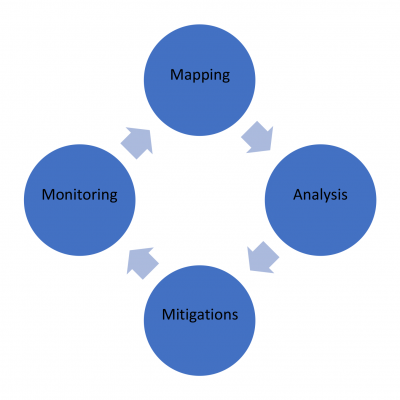Ethics considerations for manufacturing XAI: the XMANAI Ethical Evaluation Framework
The ethics implications of AI and machine learning are becoming increasingly relevant due to their implementations across several sectors. This is the case also for their application to the manufacturing domain, which is still a quite new application of AI technology.
Manufacturing can learn from what has been studied and proposed for other AI applications, and from the reflections of ethicists and philosophers who studied the ethical implications of AI.
Ethics Guidelines for Trustworthy AI and the EU approach
The EU is at the front of trying to regulate and avoid the negative impacts of AI, while a specific AI Act is in the advanced process of being approved, the High-Level Expert Group on Artificial Intelligence (AI HLEG) (an independent expert group that was set up by the European Commission as part of its AI strategy) released its document on “Ethics Guidelines for Trustworthy Artificial Intelligence”.
The guidelines first released in 2018 were revised and published in April 2019. Based on these specific Ethics Guidelines for Trustworthy AI, an AI system should have three main characteristics: be lawful, ethical, and robust. Seven main requirements have been identified by the experts to allow for that:
- Human agency and oversight – Including fundamental rights, human agency, and human oversight;
- Technical robustness and safety – Including resilience to attack and security, fallback plan and general safety, accuracy, reliability, and reproducibility;
- Privacy and data governance – Including respect for privacy, quality, and integrity of data, and access to data;
- Transparency – Including traceability, explainability, and communication;
- Diversity, non-discrimination, and fairness – Including the avoidance of unfair bias, accessibility and universal design, and stakeholder participation;
- Societal and environmental well-being – Including sustainability and environmental friendliness, social impact, society, and democracy;
- Accountability – Including audibility, minimization and reporting of negative impact, trade-offs, and redress.
While the document from the European Commission Expert Group is one of the most relevant in addressing ethical issues for AI, many other contributions exist. As highlighted by Hagendorff (2020), there are some issues related to the implementation of the identified guidelines: there are no mechanisms to ensure compliance with the various codes of ethics, and there are no consequences in case of deviations. Also, there is the risk to use ethics as a marketing strategy. One of the main need is to bridge the abstract ethics values with the specific technical implementations, so that we have effective ethical AI systems. Thus, the implementation of ethical guidelines should be tailored accordingly to the specific context of AI application (Floridi, 2019) and starting from the design phase, with AI ethics that look at individual situations and specific technical assemblages (Hagendorff, 2020). And this is the approach that we took for XMANAI and to prepare the XMANAI Ethics evaluation framework.
The objective is to provide a framework specific to manufacturing since also there is a lack of a specific framework for the manufacturing sector. At the same time, several studies highlight the ethical risks of introducing AI in the industrial sector such as in the case of loss of human skills (Torresen, 2018), and automated decision-making (Mpofu & Nicolaides, 2019). Another emergent risk, particularly relevant also in the manufacturing sector, is the liability and responsibility of AI activities (Coeckelbergh, 2020), which should be clearly defined. In this context, the value of XMANAI and its approach is to work on explainability, which together with transparency, is also a way to improve and answer liability concerns.
XMANAI approach to ethics assessment
The XMANAI ethics evaluation framework is applicable to any AI technology and solutions, already existing or to be designed. The approach wants to be a holistic approach, that considers both the AI technology to be implemented and the context where it is implemented (see Figure 1). A set of dimensions covering different ethical aspects have been defined starting from the proposal of the European Commission High-Level Expert Group on AI, but a specific dimension has been added to evaluate specifically the risks regarding the liability of AI.

The whole set of dimensions cover all the possible ethical aspects to be considered. The framework is designed to be applied with an iterative approach to evaluate and monitor the ethical risks during the different stage of XAI implementation and understand if the mitigation measures which are identified are effective.
The XMANAI ethics evaluation framework aims to facilitate a systemic and contextual approach to the ethical issues related to the design, development and implementation of these new technological solutions.
In particular, the main three goals of this tool are:
- promoting a user-friendly approach from a fair reading of contextual ethical issues;
- facilitating a dynamic and ongoing understanding of ethical principles in practice;
- introducing a consistent assessment methodology for a handy and fair trade-off of the competing interests at stake, also considering each new technological solution that could be implemented.
The implementation of the XMANAI Ethics evaluation framework is based on an iterative process divided into four steps:
- Mapping: mapping the solution being implemented in the specific context with the ethical dimensions.
- Analysis: the overall ethical performance of the XAI solutions evaluated is analyzed.
- Mitigation: design and implementation of specific mitigation measures according to the results of the analysis.
- Monitoring: mitigation results must be monitored, and the ethics dimensions can be re-assessed again in the future once some of the context conditions and/or the technology change.

This is the first step toward defining and establishing a specific AI ethics evaluation framework for the manufacturing sector to address the open issues previously discussed. The results of the XMANAI project will go in that direction, providing manufacturers and industries with a new optimized tool for starting to take into consideration the ethical dimension of AI implementation.

